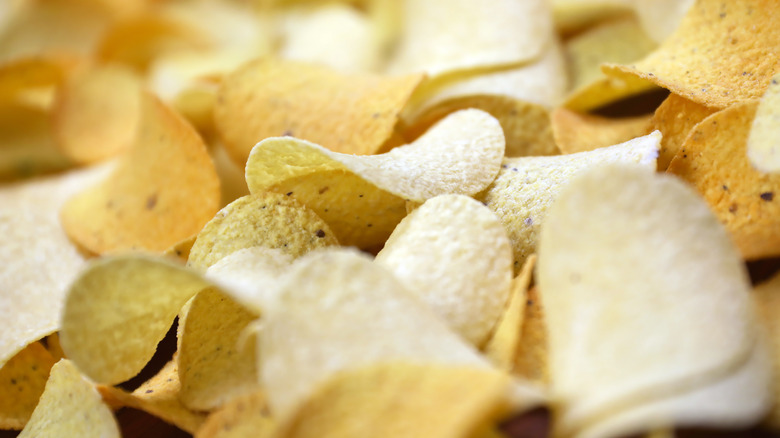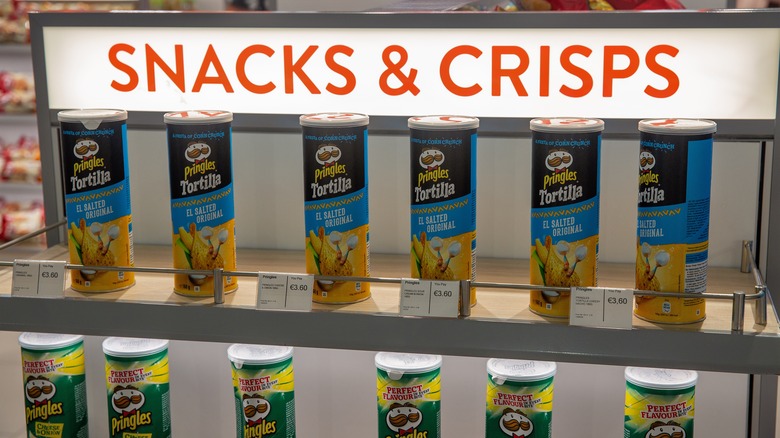The Mystery Of Pringles: Are They Actually Chips?
There are a lot of potato chip brands on the market, all peddling America's favorite savory snack, but one name clearly stands apart from the rest in terms of sheer uniqueness. One look at a Pringle tells you it's not like the others, certainly not those greasy, misshapen shards that sit around in a floppy bag just begging to be broken apart by the slightest jostle. Pringles are sleek and uniform, nestling inside each other to build a tempting tower of salty goodness. Plus, two Pringles make a perfect duck bill, and the can they come in is a great way to tease your large-handed friends. But the real reason that Pringles stand apart from all other potato chips is that they aren't really chips at all ... depending on who you ask.
Traditional chips are pretty straightforward — thinly slice a potato, fry in oil, and finish with your choice of seasonings. Pringles take a very different approach, being made from a dough with potato flakes, rice, corn, and wheat. This dough is rolled into thin sheets from which individual Pringles are stamped (like a cookie cutter). Then, each Pringle is pressed into a mold to impart its final shape before going for a bath in boiling oil. It is a markedly different approach than classic potato chips, so much so that multiple legal battles have been fought to determine whether Pringles even qualify as chips. It's a question that has dogged the snack since its earliest days.
Pringles' contentious history
As strange as it sounds, potato chips were once a fancy food available only in restaurants, but they took a huge leap in popularity in the mid-1900s, once companies like Lay's began mass-producing them. Customers found some faults, though, namely that potato chips got crushed in their bags. So in 1956, Procter & Gamble set about finding a solution. The company hired a chemist named Frederic J. Baur, who turned to geometry to devise the distinct saddle-esque shape of Pringles, technically known as a hyperbolic paraboloid. A snack made in this fashion could be neatly stacked, unlike the irregular shapes of other potato chips, thus allowing them to be packaged in a narrow and rigid tube that would be studier than a bag.
Of course, you can't slice a whole potato into perfect hyperbolic paraboloids, so Baur made his chips from a dough that could be stamped into the proper shape. Unfortunately, they tasted terrible, and the project was abandoned. Then, in the mid-'60s, another P&G employee named Alexander Liepa came up with the dough they use today. The snack was originally sold as Pringles Newfangled Potato Chips. According to The Atlantic, 'Pringle' may have come from Pringle Drive, a street in Cincinnati where two P&G advertisers lived, but others believe it was taken from Mark Pringle, a New Yorker who, in 1942, co-patented a manufacturing method similar to the one used for Pringles. They've since dropped the "Newfangled Potato Chips" tag — not by choice, but by law.
Why Pringles are not potato chips ... and why they are
When Pringles hit the market in 1968, other snack companies took issue with their "Newfangled Potato Chips" moniker. In 1975, the Food and Drug Administration stepped in to settle the matter. Their verdict? Pringles couldn't refer to its products as potato chips. In fact, the brand couldn't call its offerings 'chips' of any sort. The point of contention was the fact that Pringles don't actually contain potatoes, only potato flakes, which are made of mashed and dehydrated potatoes. That makes it pretty clear why they don't count as potato chips specifically, but ruling out the word 'chip' made as little sense then as it does now, considering how many kinds of chips there are, made from all manner of foods from corn to kale. Nevertheless, rather than argue with the FDA, Pringles instead adopted the name 'crisps.'
But there was a problem. Overseas in Great Britain, all potato chips are referred to as 'crisps,' and this came back to bite Pringles in a big way. Britain imposes a value-added tax (VAT) on purchases, which began at 10% and currently stands at 20%. Many foods are exempt from the VAT, but not potato chips, so in order to avoid paying up, P&G had to argue in court that Pringles were not chips, a.k.a. crisps. In 2009, a British court of appeals ruled that Pringles contained enough potato to count as crisps, and P&G had to pay $160 million in back taxes.


